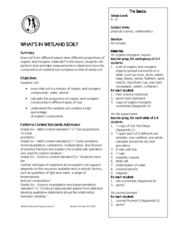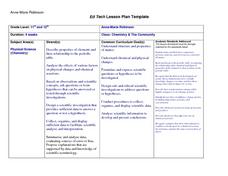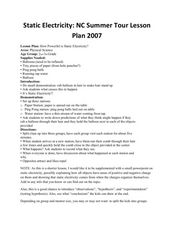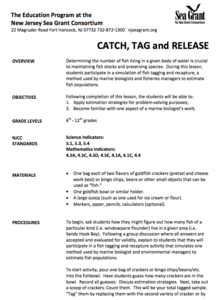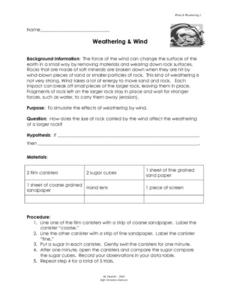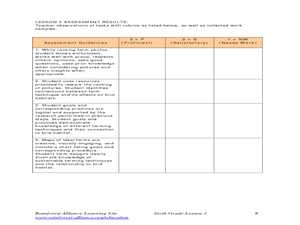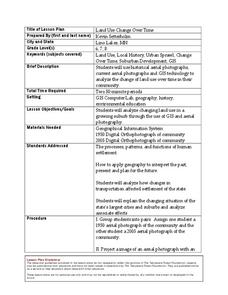Curated OER
What's in Wetland Soil?
Students examine the organic and inorganic components of soil. In this environmental science lesson, students identify the factors that influence soil formation. They collect soil samples, conduct tests, and analyze the results.
Curated OER
Chemical Formulas
Students assess how to go from writing ionic chemical formulas to nomenclature and naming chemical compounds. They brainstorm former studies and share their thoughts in small groups. A list of everyday products (shampoos, toothpaste,...
Curated OER
Chemistry & The Community
Young scholars complete a Webquest which investigates the chemistry in items such as shampoo. They research the Internet, perform a lab experiment, and write a scientific lab report with their findings. Upon completion of the activities,...
Curated OER
How Powerful is Static Electricity?
Students break up into groups to complete a demonstration rubbing a balloon in hair make their hair stand up. Thus, they conclude static electricity. They also experiment with a paper station, ping pong station and a water station...
Curated OER
Introduction to Trees and Wood
Students examine samples from various types of trees. In this trees and wood lesson, students review The Giving Tree and complete a KWL chart on trees. Students brainstorm what we get from trees and view wood samples with hand...
Curated OER
New Zealand South Island Fault Model
Students explore world geography by creating a scientific model in class. In this New Zealand lesson, students research the geography and fault lines of the South Island in New Zealand. Students utilize foam board, arts and crafts and a...
Curated OER
Catch, Tag, and Release
Learners discover how fish tagging is used by marine biologists and fisheries to estimate fish populations. Participating in a simulation, learners use estimation to determine the whole population from a small number of items.
Curated OER
Lifting a Load
Students experiments with levers to determine if the amount of force needed to lift a load is always the same. In this physics lesson, students use Lab-Pro data collector as they experiment with the fulcrum placement to measure the work...
Curated OER
'O'opu Life Cycle
Learners investigate the life cycle of the 'o'opu also known as Hawaiian gobies. In this amphidromous living lesson plan, students discuss the reproductive cycle, create props and an obstacle course to demonstrate the importance of...
Curated OER
Capillary Action and Adhesion
Students perform classroom experiments to observe adhesion. They perform a second experiment using sand, salt, water, and a heat lamp to observe the principle of capillary action. They also experiment with adhesion in plants.
Curated OER
The Fair Factor
Students participate in playing many games to determine if they are fair or not. They create their own game that is fair to play with their classmates.
Curated OER
Erosion: Natural or Unnatural
Students explore how water has the power to erode, how developing the land (building roads, buildings and parking lots) increases the amount of water reaching our rivers, and how this greater quantity of water increases erosion. They...
Curated OER
Data Analysis and Probability
Students make their own puzzle grid that illustrates the number of sit-ups students in a gym class did in one minute, then they make a histogram for this same data. Then they title their graph and label the scales and axes and graph the...
Curated OER
"The Tell-Tale Heart" by Edgar Allan Poe
In this "The Tell-Tale Heart" worksheet, students write an essay about how Edgar Allan Poe keeps the reader in suspense. The worksheet helps students construct the essay through eleven different scaffolding steps.
Curated OER
Atomic Electron Configuration and Chemical Periodicity
In this electron configuration and periodicity learning exercise, students answer fifteen questions about periodic trends and they analyze orbital diagrams indicating location of electrons.
Curated OER
Discovery 4-1 Atomic Emission Spectra
In this emission spectra worksheet, young scholars use a spectroscope to observe three types of spectra. These include continuous spectrum, emission spectrum and absorption spectrum.
Curated OER
Weathering and Wind
In this weathering and wind worksheet, students simulate the effects of weathering by wind using 2 canisters, 2 types of sandpaper and 2 sugar cubes. Students swirl the sugar cubes inside the canisters lined with fine and course...
Curated OER
Different Minerals
In this minerals worksheet, learners read about the relationship between elements, rocks and minerals. They experiment using 6 different colored gumdrops to represent 6 common elements. Students construct gumdrop and toothpick models of...
Curated OER
Random Sampling
In this random sampling worksheet, students compare data collected by a random sample to data collected by an actual count using pieces of paper with numbers written on them. They compare their data for the actual count to the random...
Curated OER
Acceleration 2
In this acceleration worksheet, students experiment with varying amounts of mass to observe the effects on the force needed to move an object. Students apply Newton's Second Law of Motion to describe the relationship between mass and...
Curated OER
Money Math: Lessons for Life
Students explore money as it applies to salary, paychecks, and taxes. In this essential mathematics lesson, students explore how math is used in various careers, how income takes are calculated and other important life lessons in math.
Curated OER
How can my breakfast help the birds?
Sixth graders design farms with a bird's habitat in mind. In this farm lesson plan, 6th graders research how sun grown coffee destroys a bird habitat, and then they make their own farm with a bird's habitat being preserved. They then...
Curated OER
Land Use Change Over Time
Students use historical aerial photographs and current aerial photographs to compare the change over time to the land. In this land changing lesson plan, students analyze, compare, contrast, and list the land change in their own community.
Curated OER
Wetland in a Pan
Seventh graders build a watershed from various materials. In this life science lesson plan, the students will be able to change the design of their watershed to see the changes in the way the water will drain. Each group will be able to...
